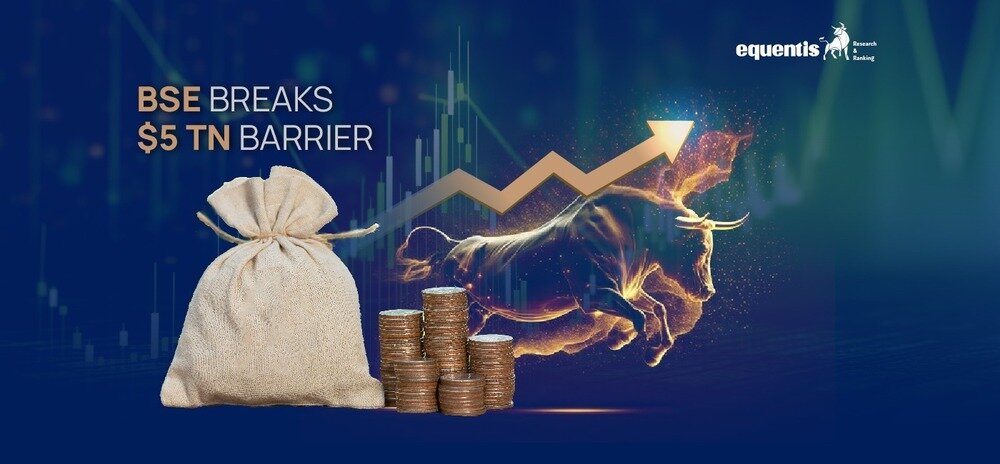In a historic moment for the Indian economy, the Bombay Stock Exchange (BSE) hit a major milestone on Tuesday. For the first time ever, all BSE-listed companies’ combined market capitalization (m-cap) topped the $5 trillion mark.
Now, the combined market capitalization of all BSE-listed companies stands at over Rs 414.16 trillion, marking an increase of more than $633 billion since the beginning of the year. While the flagship Sensex index remains 1.66 percent below its all-time high, the BSE Midcap and Smallcap indices have reached new peaks.
The journey to this milestone has been nothing short of remarkable. In just six months, the BSE’s m-cap skyrocketed from $4 trillion in November 2023 to $5 trillion. BSE-listed companies reached a market cap of $1 trillion in May 2007, doubled to $2 trillion by July 2017, and hit $3 trillion in May 2021.
5 Key Factors For BSE’s Rapid Growth
- Performance of Mid and Small Caps: The growth wasn’t limited to large-cap companies. The BSE mid-cap and small-cap indices delivered impressive returns, indicating a broader market rally.
- Expansion of Valuations: The overall market valuation witnessed significant expansion, contributing to the rise in m-cap.
- Pre-election Rally: The Lok Sabha elections likely fueled a pre-election rally, with investors anticipating positive economic policies from the winning party.
- Strong Corporate Earnings: Companies listed on the BSE reported positive earnings in the March 2024 quarter, boosting investor confidence and driving up stock prices.
- Increased Investor Participation: A growing number of retail investors entering the market has provided additional liquidity, particularly for mid- and small-cap stocks. These investors may be attracted to the higher potential returns offered by smaller companies.
This achievement places India among an elite group of nations. The country joins the exclusive club of economies with a stock market m-cap exceeding $5 trillion. Only four stock markets worldwide are in the $ 5 trillion-plus club: the USA ($55.65 trillion), China ($9.4 trillion), Japan ($6.42 trillion), and Hong Kong ($5.47 trillion).
According to Bloomberg, India’s market cap rose nearly 12 percent in 2024, the US saw a 10 percent increase, and Hong Kong’s grew by 16 percent. Conversely, China’s market cap declined by 1.4 percent, and Japan’s increased by 3 percent.
| World Market | Market Capitalization (Dollar Trillion) |
| USA | 55.65 |
| China | 9.4 |
| Japan | 6.42 |
| Hong Kong | 5.47 |
Indian stock valuations remain higher than some Asian counterparts, the country boasts a robust economic outlook. This optimism stems from several positive indicators:
- Strong Macroeconomic Fundamentals: Low inflation, anticipated interest rate cuts, and increased industrial activity paint a favorable economic picture.
- Policy Continuity: Markets are factoring in expectations for consistent government policies, fostering stability.
- Promising Growth Trajectory: India’s projected GDP growth of 7% for FY25 allows the RBI room to maintain rates at 6.5%, supporting economic activity.
- Falling Inflation & Favorable Monsoon: Declining headline inflation and a positive monsoon forecast are expected to ease price pressures, benefiting consumers and businesses.
- Positive High-Frequency Indicators: Purchasing Managers’ Indexes (PMIs), Goods and Services Tax (GST) collections, and domestic passenger growth all show positive trends compared to historical data, indicating a vibrant domestic economy.
However, experts caution that there are factors to consider beyond the headline number. This suggests that the market might be slightly overvalued, and future growth could depend on consistent economic performance. Analysts point to three key areas that will determine whether India’s stock market can maintain this momentum:
- Growth (G): The Indian economy needs to sustain its growth trajectory to justify the current market valuations.
- Governance (G): Strong corporate governance practices and a transparent regulatory environment are crucial to attracting and retaining long-term investors.
- Green (G): India’s commitment towards sustainable development and tackling climate change will be a critical factor for attracting environmentally conscious global investors.
The future of the Indian stock market remains to be seen. While the $5 trillion milestone is a cause for celebration, it’s also a call for introspection. Continued economic growth, robust corporate governance, and a focus on sustainability will be instrumental in ensuring that the Indian stock market scales even greater heights in the years to come.
*Disclaimer Note: The securities quoted, if any, are for illustration only and are not recommendatory. This article is for education purposes only and shall not be considered as recommendation or investment advice by Research & Ranking. We will not be liable for any losses that may occur. Investment in securities market are subject to market risks. Read all the related documents carefully before investing. Registration granted by SEBI, membership of BASL, and certification from NISM in no way guarantee the performance of the intermediary or provide any assurance of returns to investors.
FAQs
What does “BSE reaching $5 trillion” mean?
The BSE (Bombay Stock Exchange) is a major stock exchange in India. When we say the BSE “reached $5 trillion,” it refers to the combined market capitalization (m-cap) of all companies listed on the exchange surpassing $5 trillion for the first time ever. M-cap is the total market value of all a company's outstanding shares.
Is this a good thing?
Reaching $5 trillion is a positive sign for the Indian economy. It signifies investor confidence and growth in the Indian stock market.
How useful was this post?
Click on a star to rate it!
Average rating 3 / 5. Vote count: 2
No votes so far! Be the first to rate this post.
I’m Archana R. Chettiar, an experienced content creator with
an affinity for writing on personal finance and other financial content. I
love to write on equity investing, retirement, managing money, and more.
-
Archana Chettiarhttps://www.equentis.com/blog/author/archana/
-
Archana Chettiarhttps://www.equentis.com/blog/author/archana/
-
Archana Chettiarhttps://www.equentis.com/blog/author/archana/
-
Archana Chettiarhttps://www.equentis.com/blog/author/archana/

